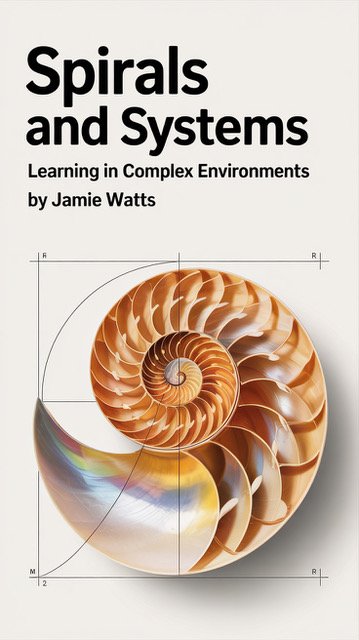 Image 1 of 1
Image 1 of 1


Spirals and Systems: Learning In Complex Environments
Learning doesn’t move in straight lines. It spirals. And it lives inside systems.
Too often, classrooms are treated like machines: inputs, outputs, control. But real learning is not mechanical—it’s complex, adaptive, and alive. It unfolds through rhythm, return, and relationship. When systems ignore this, something essential gets lost.
Spirals and Systems is a two-part invitation to see learning differently.
Part I—Seeing the Systems introduces classrooms, schools, and communities as complex adaptive systems. With language drawn from systems theory and grounded in classroom life, Jamie Watts explores what it means to teach inside dynamic, relational environments—where small changes ripple, feedback loops matter, and culture is always under construction.
Part II—Building the Spiral maps the five-phase pattern at the heart of meaningful learning:
Instinct → Stimulus → Activity → Feedback → Culture.
This is the Instinct-to-Culture Spiral—a model for how learners engage, how meaning takes shape, and how design can support (or interrupt) the process of return.
Across both parts, Watts weaves together theory, practice, and design tools for educators, leaders, and anyone working to make space for what’s real in the learning process.
Inside you’ll find:
A systems-thinking lens for understanding classrooms as living ecosystems
Design strategies that support rhythm, feedback, and responsiveness
A developmental spiral that honors instinct, agency, and deepening meaning
Practical guidance for noticing and supporting learning in motion—especially when it doesn’t look linear
This book isn’t a script. It’s a way of seeing.
It doesn’t offer easy answers—but it gives you better questions, and a clearer path for responding.
Because learning doesn’t just happen.
It spirals.
And the system shapes whether it can return.
Learning doesn’t move in straight lines. It spirals. And it lives inside systems.
Too often, classrooms are treated like machines: inputs, outputs, control. But real learning is not mechanical—it’s complex, adaptive, and alive. It unfolds through rhythm, return, and relationship. When systems ignore this, something essential gets lost.
Spirals and Systems is a two-part invitation to see learning differently.
Part I—Seeing the Systems introduces classrooms, schools, and communities as complex adaptive systems. With language drawn from systems theory and grounded in classroom life, Jamie Watts explores what it means to teach inside dynamic, relational environments—where small changes ripple, feedback loops matter, and culture is always under construction.
Part II—Building the Spiral maps the five-phase pattern at the heart of meaningful learning:
Instinct → Stimulus → Activity → Feedback → Culture.
This is the Instinct-to-Culture Spiral—a model for how learners engage, how meaning takes shape, and how design can support (or interrupt) the process of return.
Across both parts, Watts weaves together theory, practice, and design tools for educators, leaders, and anyone working to make space for what’s real in the learning process.
Inside you’ll find:
A systems-thinking lens for understanding classrooms as living ecosystems
Design strategies that support rhythm, feedback, and responsiveness
A developmental spiral that honors instinct, agency, and deepening meaning
Practical guidance for noticing and supporting learning in motion—especially when it doesn’t look linear
This book isn’t a script. It’s a way of seeing.
It doesn’t offer easy answers—but it gives you better questions, and a clearer path for responding.
Because learning doesn’t just happen.
It spirals.
And the system shapes whether it can return.